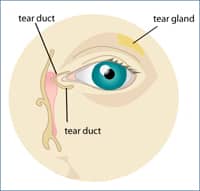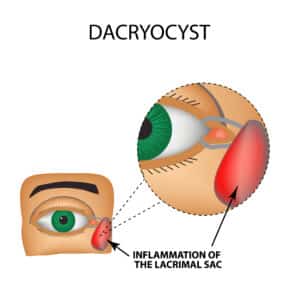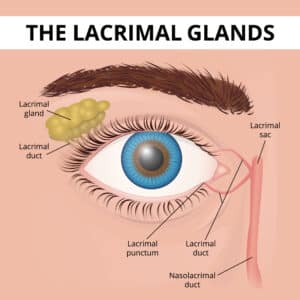You have probably heard about many conditions affecting the eye itself, but have you heard of tear duct and eye socket disorders? The eye can only work well if its supporting structures are functioning properly.
When one of these areas is affected, it can compromise your vision in various ways.
Keep reading to learn more about this unique group of disorders, including their causes and how to treat them.
Tear Duct Disorders

An essential component of the eye’s drainage system, tear ducts are small tubes that run from the eyes to the nose. When they function correctly, your tear ducts transport tears away from the eye to the nasal cavity. After your tears make it to the nasal cavity, you can eliminate them from your system by absorbing them or by swallowing them.
A tear duct disorder occurs when an obstruction gets in the way of the flow of tears from the eye. Instead of exiting the eye area, tears begin to accumulate. The blockage can be full or partial.
There are many potential causes of a tear duct disorder. Some individuals are born with it, while others develop it after infection, inflammation, or eye disease. It can also result from ocular trauma or be a product of aging and getting older.
Symptoms of tear duct disorders include:
- Watery eyes
- Blurry vision
- Mucus discharge from the eye
- Crusting of eyelids
- Recurring eye infections
- Swelling on the side of the nose
There are multiple types of tear duct disorders:
Congenital Nasolacrimal Duct Obstruction
Congenital nasolacrimal duct obstruction occurs when the tear duct fails to open up as it should at birth.
Acquired Nasolacrimal Duct Obstruction
Acquired nasolacrimal duct obstruction results from a blockage that develops after reaching adulthood. The most common complaint with this blockage is usually tearing, but patients can also have other symptoms.
Dacryocystitis

Dacryocystitis is an acute infection of the tear sacs or lacrimal sacs. A nasolacrimal duct obstruction generally causes it.
Punctal Stenosis
Punctal stenosis occurs when the puncta (small openings that drain tears from your eyes) are not wide enough.
Lacrimal Gland and Lacrimal Sac Tumors
Lacrimal gland and lacrimal sac tumors are rare but can affect the eye’s tear gland.
Treatment for Tear Duct Disorders
The best treatment for a particular tear duct obstruction depends on the type and severity of the disorder. When treating any tear duct obstruction, the goal is to help tears drain appropriately by opening up or bypassing a blockage.
Massaging the lacrimal sac and using warm compresses can be beneficial if the condition is milder. Thorough cleaning of the eyelids can also be helpful. If there is an infection, your eye doctor may prescribe antibiotic eye drops and creams.
Probing is another option. During this straightforward outpatient procedure, the ophthalmologist enlarges the punctal openings. They then flush out the tear duct.
In more severe cases, surgery may be the best course of action. Stents are placed between the lacrimal sac and the nose to circumvent the blockage. These tiny tubes are typically left in for a few months while healing occurs.
Balloon catheter dilation is another option if other treatments are unsuccessful or the obstruction reappears. This procedure widens the tear duct by inserting a deflated balloon through the blocked area. Your eye doctor then inflates and deflates the balloon a few times to clear the way.
Tear duct obstructions are relatively common in newborns. Often, a thin tissue membrane covers the nasolacrimal duct. This type of obstruction usually clears up on its own as the baby’s drainage system matures.
Eye Socket Disorders

The eye socket (also called the orbit) is a cavity that contains and protects the eye with all its nerves and muscles. It helps keep the eye as safe as possible from injury.
Thyroid eye disease, which is also called Graves’ eye disease, occurs when the thyroid functions too much or too little.
With this immune system disorder, the area around an individual’s eyes can become inflamed. Symptoms can range from a dry or gritty sensation to swelling and vision loss.
Orbital cellulitis is an infection that affects the tissues in and around the eye socket. The infection can spread from the sinuses, teeth, or bloodstream to this area. Symptoms include redness, swelling, pain, and impaired vision.
As with tear duct disorders, it is also possible for a tumor to form in the eye socket area or spread from the nearby nasal area, although rare.
Treatment for Eye Socket Disorders

At-home methods like warm compresses can help relieve the symptoms of thyroid eye disease. If the eyes feel irritated due to being dry or watery, you can soothe them with lubricating eye drops or ointment.
Your eye doctor may prescribe anti-inflammatory medications like steroids. In severe cases, radiation or surgery may be necessary.
In cases of orbital cellulitis, patients are typically admitted to the hospital and given antibiotics. If antibiotics alone are not successful, the next step may be surgery.
In the uncommon event of a tumor, treatment will depend on the type of tumor. Treating a tumor can range from drugs, laser therapy, and surgical removal (if benign) to traditional therapy and chemotherapy (if malignant).
Are you experiencing one or more of the above symptoms? Don’t wait—schedule an appointment at Takle Eye Group in Griffin, GA, today!




